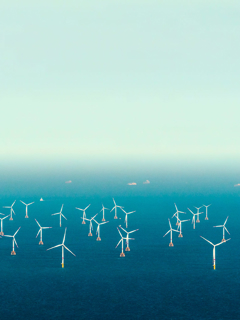Power-to-X (P2X), still a relatively new concept but as projects begin to take shape, it is now seen as an essential energy source for tomorrow as the world undergoes the painful process of weaning itself off hydrocarbons. Of course, this won’t happen any time soon – unless we opt to live without light, heat, air conditioning, industry, food or transport. But the complex P2X systems, their engineering and assurance, will be years in the making and R&D is well under way in a range of locations.
As is often the case with new technologies, definitions are a challenge. Some internet definitions suggest that P2X is a source of power that uses excess renewable energy to generate other forms of power that can be stored or reconverted. But this is only part of the picture.
Mark Tipping is LR's Global Power-to-X Director. He explained that this is certainly where P2X concepts first took shape – you can’t stop a river or turn the wind off, so it makes sense to use any extra energy to make some more. But today, P2X covers a wide range of applications based on facilities specifically designed and built for the purpose. Tipping gives four examples:
- Clean power for clean fuel production – hydrogen, ammonia, synthetic hydrocarbons
- Buffering for renewable sources – hydrogen fuel cells, batteries, nuclear power
- Clean power for oil and gas production – electrification
- Clean power for carbon capture and storage – electrification
There are already some examples, but not many. Power from shore for oil and gas production is the most obvious. Some energy fields in locations including Abu Dhabi and Norway use solar power and hydroelectricity respectively. Meanwhile, Norway’s state energy firm, Equinor, is using electricity generated at the Hywind Tampen offshore wind farm for the electrification of oil and gas production at the Snorre and Gullfaks fields. And since the decarbonisation of oil and gas production is a top priority, more of these P2X applications are likely in the short run.
Know your colours
Ultimately, the aim is to replace today’s hydrocarbon energy with renewable power that does not inflict more damage on the planet. And it is likely that some existing offshore infrastructure – such as pipelines, jackets and jack-ups – will be repurposed as part of this process. Tipping notes that this will generate significant assurance challenges that LR is gearing up to meet.
Although there are many possible zero-carbon fuels – wind, waves, solar, geothermal, hydropower, biomass, biogas, landfill gas, sewage treatment plant gas to name a few – it is the adoption of hydrogen as an energy source that is likely to be a key focus. But it’s more complicated than that because hydrogen comes in a range of different colours:
- Blue – likely to be the first step where natural gas is split into hydrogen and carbon dioxide by Steam Methane Reforming or Auto Thermal Reforming, with carbon capture and storage
- Purple – created with nuclear power, a technology that is available today but suffers from opposition
- Green – the end objective but only available in very small quantities so far
Tipping stresses the importance of these colours. An estimated 99% of hydrogen produced today comes from fossil fuels and it only ‘turns’ blue with carbon capture and storage. According to CertifHy, green hydrogen is defined as hydrogen produced from a process that releases less than 36.4 grams of CO2 equivalent per mega-joule (60% less than the steam methane reforming process) and uses a renewable energy source for power requirements.
Harnessing ‘stranded’ energy
A key benefit of P2X is the opportunity to harness energy that would otherwise be ‘stranded’ – in other words, too expensive to make available wherever needed. Take a future floating wind facility, for example, sited far from shore. The size OFFSHOREand length of cables to take electricity to shore and the energy loss in the process would make harnessing this potential energy uneconomic.
However, using the wind to provide energy to create green hydrogen from sea water through hydrolysis would enable the energy that would otherwise be wasted to be developed. The resulting hydrogen could then be piped or shipped ashore to provide energy for power grids or local industries.
LR has been involved in the verification of a first test project in this field. Following the successful development of 2MW prototype, ERM’s Deepwater Offshore Local Production of Hydrogen (Dolphyn) project has moved on to the next phase. The global consultancy headquartered in London, is now developing a 10MW commercial demonstrator off the coast of Aberdeen, with the Front End Engineering Design stage under way and likely to take until Autumn 2022.
"We understand that this is a nascent industry."
Nascent industry
ERM expects that the plant will provide the basis for development of a series of commercial scale P2X facilities, targeted to generate 100-300 MW at several locations later this decade, expanding to multi-GW scale developments in the 2030s. LR is playing a role in offshore hydrogen production and Tipping stresses the challenges of providing assurance services for offshore hydrogen production which is a new energy technology.
“We understand that this is a nascent industry,” he told Horizons, “and the necessary regulatory backdrop is not yet clear. However, with our extensive offshore experience, we are well-placed to set up the necessary assurance procedures and tell our clients what’s acceptable, and what ‘good’ looks like. Our aim is to support projects like ERM Dolphyn over their entire lifecycle.”
In August, ERM signed a Memorandum of Understanding with Ireland’s Simply Blue Energy and Subsea 7 to assess whether Dolphyn technology could be suitable for the energy developers’ Salamander wind farm off Peterhead on the east coast of Scotland. Partners in this project are understood to be negotiating with Scotwind, Scotland’s seabed leasing agency, for a suitable site where a 200MW floating wind farm could be developed.
Aligning the two projects could pave the way for other similar developments, according to experts, and push P2X right to the front of renewable energy development and green hydrogen production. It would also make a significant contribution to the UK Government’s aim to have one gigawatt of floating wind power in place by 2030, and 5GW of green hydrogen capacity.








